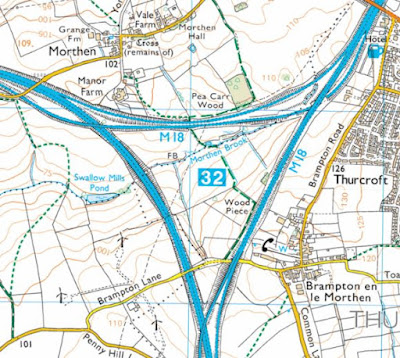 |
| The lodge to Oaks Park |
After a period of 8 months travelling all over Sheffield on various buses, to see the remaining 47 Sheffield Board Schools, plus the Central Schools at Leopold Street, I finished this project at Whitby Road Council School - during my exploration of Darnall in the last week of October 2021.
To make a good day out with a decent walk, I planned my trips to include listed buildings in the vicinity that didn’t yet have a photograph on the British Listed Buildings website, which would in turn give me a better understanding of the building stones of Sheffield and how they relate to the underlying Upper Carboniferous geology.
For my next short venture, I decided to go and further investigate the listed buildings of Norton, which had developed into one of my favourite places in Sheffield, having visited the area around St. James’ church and the adjoining Graves Park several times in recent years – including a field trip with the Sheffield U3A Geology Group, to explore the Greenmoor Rock, which started at the Morrisons supermarket at Meadowhead.
Various quarries once worked the Greenmoor Rock in the area and, although Grenoside Sandstone appears to have been used for St. James’ church and other substantial buildings, it is this stone that has been mainly used around Norton, Graves Park and also around Greenhill for the smaller houses and cottages.
Alighting from the No. 1 bus from Sheffield on Norton Lane, the first building on my list was the west lodge to Oaks Park, where I immediately recognised the very regular thinly bedded Greenmoor Rock in the dry stone boundary wall, with its very distinctive dark brown iron staining on many joint faces.
The lodge itself has walling that is coarser a grained and more uniformly coloured, which may be from more massive beds in this formation and are used for general building, rather than the paving and headstones for which it was best known. The dressings, however are a yellowish, cross-bedded massive sandstone with iron staining and this is presumably the same stone used for the Georgian house, which I did not get to see.
Continuing down School Lane and then on to Cypress Avenue, the School House, the Post Office House and Chantrey Cottage are all obscured by tall boundary walls, dense hedges and trees and it was only Grooms Cottage (c1800) that I could quite clearly see. The latter looks like it is built with Greenmoor Rock walling and probably the stone roof tiles too, which have a much smoother surface than those made with the Rough Rock.
The mid C18 Jordanthorpe Hall Farmhouse on Cinderhill Lane could also only be seen at a distance and the physical characteristics of the stonework seem quite varied, with both the colouration of the sandstone and the height and regularity of the various courses not being typical of the Greenmoor Rock with which I was familiar.
Crossing over the Bochum Parkway, I could not get access to the birthplace of the sculptor Sir Francis Chantrey, Chantrey House, due to it being in the grounds of the Mossbrook Infant School or Jordanthorpe House. I did, however, manage to photograph the latter from the unmade verge on the roundabout, from which there wasn’t a great view but enough to suggest that the yellowish sandstone used is Grenoside Sandstone.
Making my way back up Norton Lane towards St. James’ church, from the limited views I had of it, the lodge to Norton nursery (c1870) looks like a further example of grey/brown thinly bedded Greenmoor Rock, with a Welsh slate fish scale roof.
Next to the lodge, the old school (c1740) provides an example of how the Greenmoor Rock, laid with various thicknesses of the beds, has been used for the gable ends to the original house and for all of the walling to the southernmost extension, whereas the eastern front elevation is built in Grenoside Sandstone ashlar.
After taking a few snaps of the brick built Norton Hall Farm (c1802), I quickly made my way across Graves Park to the north entrance on Cobnar Road, where the lodge (c1870) is built in squared Greenmoor Rock of a moderate bed height, with massive sandstone that is probably from Derbyshire used for the dressings.
























































